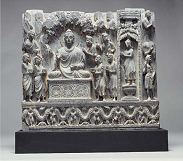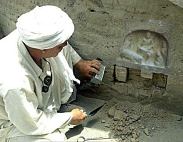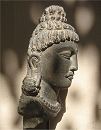Gandhara (also spelled Gandhara) is the name given to an ancient region or province invaded by Alexander the Great, who took Charsadda, near the present day Peshawar in Pakistan and then marched eastwards across the Indus into Punjab in India and on as far as the Beas river (ancient Vipasa). Gandharan art however, during the first centuries of the Christian era, embraced a considerably larger area including parts of present day Afghanistan, and drew on its influences from Buddhist, Hindu and even Greek art.
 Gandharan sculpture survives today dating from the first to probably as late as the sixth or seventh century but always in a remarkably homogenous style, almost always in a blue-grey mica schist stone, though sometimes in a green phyllite or in stucco or, very rarely, in terracotta. Not all the quality of Gandharan output was high. Because of the appeal of its Western classical aesthetic for the British rulers of India at the time of the British Raj, who were schooled to admire all things Greek and Roman, a great deal of Gandharan art found its way into private hands or the in the shelter of museums.
Gandharan sculpture survives today dating from the first to probably as late as the sixth or seventh century but always in a remarkably homogenous style, almost always in a blue-grey mica schist stone, though sometimes in a green phyllite or in stucco or, very rarely, in terracotta. Not all the quality of Gandharan output was high. Because of the appeal of its Western classical aesthetic for the British rulers of India at the time of the British Raj, who were schooled to admire all things Greek and Roman, a great deal of Gandharan art found its way into private hands or the in the shelter of museums.
In the first to third centuries CE, the Gandharan region saw a period of exceptional prosperity under the rule of the Kushans, a dynasty originating in Central Asia. A prosperous merchant class grew up and these merchants, and together with the Kushan rulers, endowed many Buddhist monasteries and shrines. By commissioning these works, such as this sculpture, the patron, according to Buddhist thought, acquired merit in this life, which could lead to a better existence in the future.
Gandharan civilization flourished here for many centuries (reaching a remarkable level of maturity) and is particularly remembered for its Buddhist sculpture & art. During this period, thousands of monasteries and stupas were built and lavishly adorned with statues of Buddha, typically carved from grey metamorphic rock technically referred to as "schist", featuring narrative scenes from the life of "Buddha in his many reincarnations".
 The great cultural and spiritual Gandharan sites of Taxila, Takht-Bhai and Udegram in the Swat Valley are renowned for the vibrant Buddhist art and sculpture. The Swat Valley has over 100 known archeological sites in the valley with less than 10% that have been excavated. As the work continues, many fine artifacts, such as the one featured on this page, are being unearthed, and some ultimately make their way to the west.
The great cultural and spiritual Gandharan sites of Taxila, Takht-Bhai and Udegram in the Swat Valley are renowned for the vibrant Buddhist art and sculpture. The Swat Valley has over 100 known archeological sites in the valley with less than 10% that have been excavated. As the work continues, many fine artifacts, such as the one featured on this page, are being unearthed, and some ultimately make their way to the west.
 Gandharan art is some of the earliest renderings of the historical Buddha. Prior to the 1st or 2nd century there is no surviving iconography of the Buddha. Gandharan art is heavily influenced by the Greco-Roman style of sculpture which was prevalent at the time. Thus the facial characteristics of Gandharan pieces tend to be Romanesque - much more European than later periods when Buddhist sculpture took on a decidely Asian flair.
Gandharan art is some of the earliest renderings of the historical Buddha. Prior to the 1st or 2nd century there is no surviving iconography of the Buddha. Gandharan art is heavily influenced by the Greco-Roman style of sculpture which was prevalent at the time. Thus the facial characteristics of Gandharan pieces tend to be Romanesque - much more European than later periods when Buddhist sculpture took on a decidely Asian flair.
 Gandharan images of the Buddha have certain common characteristics... the flowing robes draped around the shoulders and across the body, with the hair in loose flowing curls rather than the tight ringlets characteristic of later sculptures. The hair is drawn up into a bun which is the ushnisha, the protuberance at the top of the head which represents the flame of supreme enlightenment. Gandharan sculptures of the Buddha almost always have the urna as well, the "third eye" in the middle of the forehead. Gandharan sculptures are typically either modelled stucco, a mixture of cement, sand and/or limestone... or they are carved from schist, a metamorphic rock like basalt with a preponderance of lamellar minerals like mica or chlorite. It is the mica which gives certain schist sculptures their glitter or sparkle.
Gandharan images of the Buddha have certain common characteristics... the flowing robes draped around the shoulders and across the body, with the hair in loose flowing curls rather than the tight ringlets characteristic of later sculptures. The hair is drawn up into a bun which is the ushnisha, the protuberance at the top of the head which represents the flame of supreme enlightenment. Gandharan sculptures of the Buddha almost always have the urna as well, the "third eye" in the middle of the forehead. Gandharan sculptures are typically either modelled stucco, a mixture of cement, sand and/or limestone... or they are carved from schist, a metamorphic rock like basalt with a preponderance of lamellar minerals like mica or chlorite. It is the mica which gives certain schist sculptures their glitter or sparkle.
 Accurate Gandharan reproductions are rarely found in the art world, perhaps because people decorating their homes with Asian pieces seem to prefer the decidely Asian renderings of later periods... and art collectors who will pay the big money for genuine Gandharan art will ultimately know the difference. The Villa Del Prado Light of Asia Collection has one piece in the ivory collection which strongly resembles the Gandharan period though it was carved in the last century (see image at the right - click to see it full size).
Accurate Gandharan reproductions are rarely found in the art world, perhaps because people decorating their homes with Asian pieces seem to prefer the decidely Asian renderings of later periods... and art collectors who will pay the big money for genuine Gandharan art will ultimately know the difference. The Villa Del Prado Light of Asia Collection has one piece in the ivory collection which strongly resembles the Gandharan period though it was carved in the last century (see image at the right - click to see it full size).
Gandharan art is highly prized by collectors with larger pieces often bringing upwards of a million dollars at major auction houses like Sotheby's. The priceless grey schist bust sculpture featured at the top of this page is unusual is remarkable for the perfect state of preservation relative to its antiquity.
See all the fine sculptures in the Villa Del Prado Light of Asia Collection Online.









 Gandharan sculpture survives today dating from the first to probably as late as the sixth or seventh century but always in a remarkably homogenous style, almost always in a blue-grey mica schist stone, though sometimes in a green phyllite or in stucco or, very rarely, in terracotta. Not all the quality of Gandharan output was high. Because of the appeal of its Western classical aesthetic for the British rulers of India at the time of the British Raj, who were schooled to admire all things Greek and Roman, a great deal of Gandharan art found its way into private hands or the in the shelter of museums.
Gandharan sculpture survives today dating from the first to probably as late as the sixth or seventh century but always in a remarkably homogenous style, almost always in a blue-grey mica schist stone, though sometimes in a green phyllite or in stucco or, very rarely, in terracotta. Not all the quality of Gandharan output was high. Because of the appeal of its Western classical aesthetic for the British rulers of India at the time of the British Raj, who were schooled to admire all things Greek and Roman, a great deal of Gandharan art found its way into private hands or the in the shelter of museums.
 The great cultural and spiritual Gandharan sites of Taxila, Takht-Bhai and Udegram in the Swat Valley are renowned for the vibrant Buddhist art and sculpture. The Swat Valley has over 100 known archeological sites in the valley with less than 10% that have been excavated. As the work continues, many fine artifacts, such as the one featured on this page, are being unearthed, and some ultimately make their way to the west.
The great cultural and spiritual Gandharan sites of Taxila, Takht-Bhai and Udegram in the Swat Valley are renowned for the vibrant Buddhist art and sculpture. The Swat Valley has over 100 known archeological sites in the valley with less than 10% that have been excavated. As the work continues, many fine artifacts, such as the one featured on this page, are being unearthed, and some ultimately make their way to the west.
 Gandharan art is some of the earliest renderings of the historical Buddha. Prior to the 1st or 2nd century there is no surviving iconography of the Buddha. Gandharan art is heavily influenced by the Greco-Roman style of sculpture which was prevalent at the time. Thus the facial characteristics of Gandharan pieces tend to be Romanesque - much more European than later periods when Buddhist sculpture took on a decidely Asian flair.
Gandharan art is some of the earliest renderings of the historical Buddha. Prior to the 1st or 2nd century there is no surviving iconography of the Buddha. Gandharan art is heavily influenced by the Greco-Roman style of sculpture which was prevalent at the time. Thus the facial characteristics of Gandharan pieces tend to be Romanesque - much more European than later periods when Buddhist sculpture took on a decidely Asian flair.


